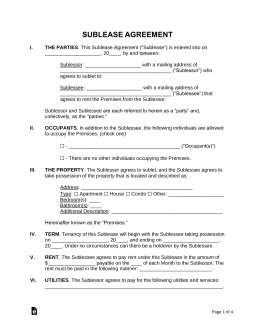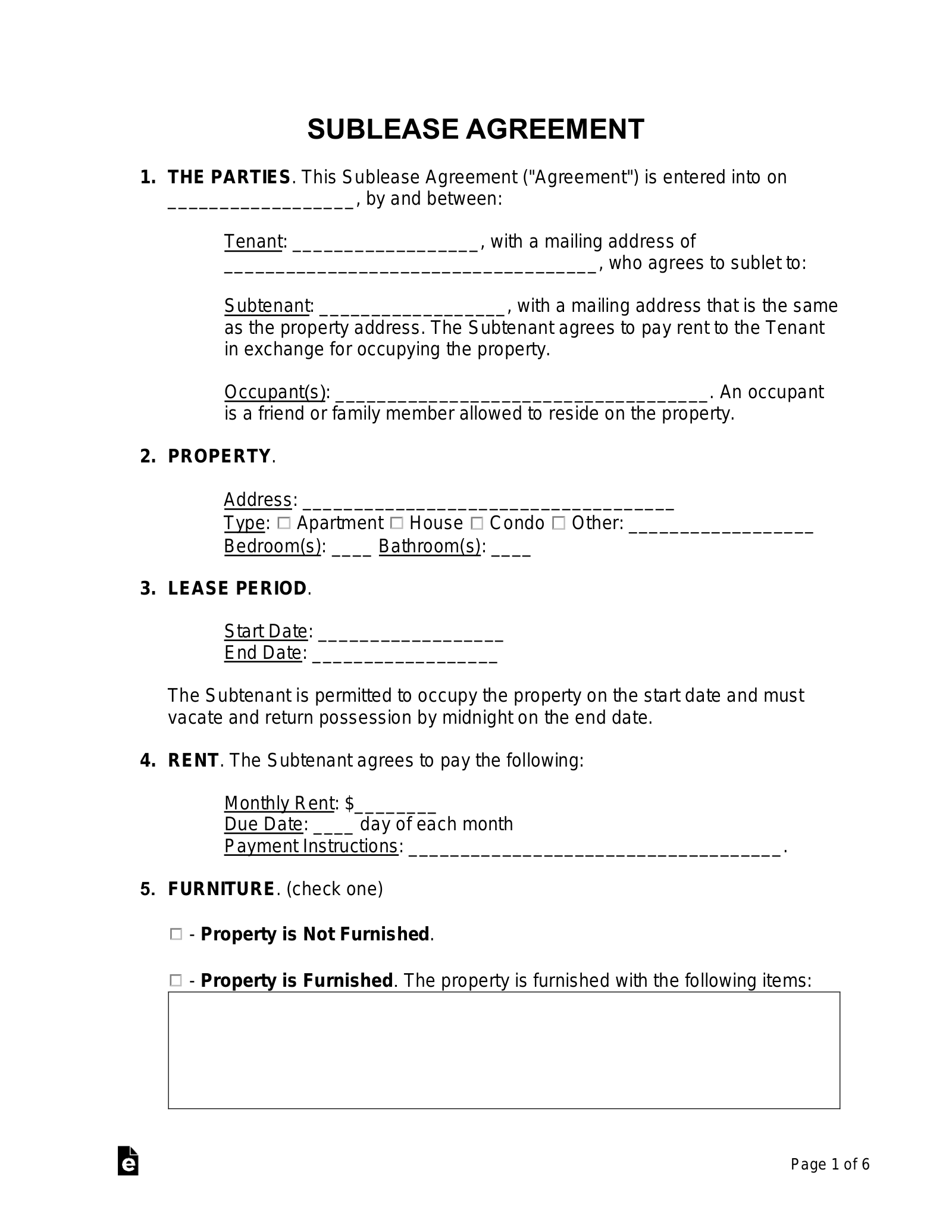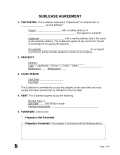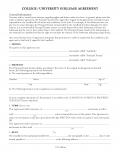Updated November 08, 2023
A sublease agreement is a legal document that allows a tenant to re-rent their property to someone else (subtenant). Also known as “subletting,” a tenant must obtain the landlord’s permission before renting to subtenants (unless permitted to do so in the original lease).
The end date of a sublease cannot extend beyond the term of the original lease unless the tenant gets the landlord’s authorization.
By State
- Alabama
- Alaska
- Arizona
- Arkansas
- California
- Colorado
- Connecticut
- Delaware
- Florida
- Georgia
- Hawaii
- Idaho
- Illinois
- Indiana
- Iowa
- Kansas
- Kentucky
- Louisiana
- Maine
- Maryland
- Massachusetts
- Michigan
- Minnesota
- Mississippi
- Missouri
- Montana
- Nebraska
- Nevada
- New Hampshire
- New Jersey
- New Mexico
- New York
- North Carolina
- North Dakota
- Ohio
- Oklahoma
- Oregon
- Pennsylvania
- Rhode Island
- South Carolina
- South Dakota
- Tennessee
- Texas
- Utah
- Vermont
- Virginia
- Washington
- Washington D.C.
- West Virginia
- Wisconsin
- Wyoming
By Type (2)
Download: PDF, MS Word, OpenDocument
Download: PDF
Table of Contents |
What is a Sublease?
A sublease is a rental contract that allows a tenant (sublessor) to re-rent their place to a subtenant (sublessee). This requires the landlord’s consent due to subletting being prohibited in the lease between the tenant and landlord, the “original” or “master” lease.
A sublease cannot go further than the end date of the master lease unless approved by the landlord.
A Sublease Occurs When
(1) A tenant wants to terminate their lease early but is rejected by the landlord and instead rents to a subtenant until the expiration of the lease; or
(2) A tenant wants to remain on the property while renting a room to a subtenant.
Landlord’s Consent
 Landlord Consent Form – Allows a tenant to obtain permission from the landlord to sublet a property.
Landlord Consent Form – Allows a tenant to obtain permission from the landlord to sublet a property.
Download: PDF, MS Word, OpenDocument
How to Sublet an Apartment (7 steps)
- Find the Original Lease
- Determine the Monthly Rent
- List the Property
- Show the Property
- Screen the SubLessee
- Add Disclosures and Addendums
- Sign the Sublease
1. Find the Original Lease
 The original lease is needed to be found to view the tenant’s rights regarding subletting the premises. Most standard leases do not allow the tenant to sublease the property. Therefore, the tenant may be required to obtain a Landlord Consent Form to forgo what was originally agreed to and attach it as an addendum.
The original lease is needed to be found to view the tenant’s rights regarding subletting the premises. Most standard leases do not allow the tenant to sublease the property. Therefore, the tenant may be required to obtain a Landlord Consent Form to forgo what was originally agreed to and attach it as an addendum.
Once consent has been given, the tenant may begin marketing the property for lease.
2. Determine the Monthly Rent
 This involves the tenant figuring out how much to charge the sublessee. The market rent can be determined by considering what others are paying in the area via Craigslist, Apartments.com, and Zillow.
This involves the tenant figuring out how much to charge the sublessee. The market rent can be determined by considering what others are paying in the area via Craigslist, Apartments.com, and Zillow.
After viewing “like properties,” the tenant may get an idea of what to make for the asking price.
3. List the Property
 Use the following websites when subleasing a property:
Use the following websites when subleasing a property:
- Sublet.com – 90-day access for $19.95 (in most areas).
- Craigslist (sublets / temporary) – Flat fee ($) per post. Fee depends on location.
- Flip.lease – Subtenant pays 5% of the monthly amount.
- Airbnb– Determined on the location and amount.
It’s recommended to use the same property photos and details to create listings on all the above-listed websites.
4. Show the Property
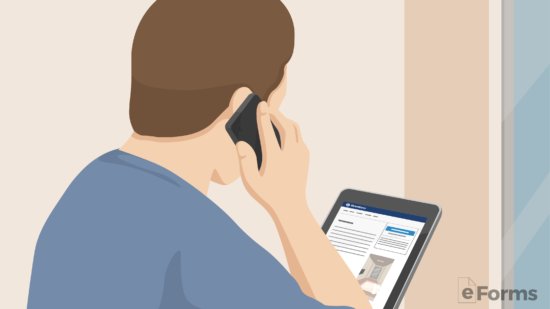 While accepting the incoming calls on the property, it is most important for the tenant to be as available as possible, especially if the property has been priced below market, to get the property rented as quickly as possible.
While accepting the incoming calls on the property, it is most important for the tenant to be as available as possible, especially if the property has been priced below market, to get the property rented as quickly as possible.
In order to save time, make sure to vet the prospective sublessees over the phone to make sure the following:
- They are looking to move in immediately;
- They are currently employed;
- They can afford the monthly asking price (rent); and
- They don’t have pets (if there’s a pet policy).
After pre-approving the individual(s) on the phone, it is time to create a time to show the property to see if it matches their needs.
5. Screen the SubLessee
 Before accepting a lease, the tenant should accept the credentials of the sublessee through a Rental Application, collect a fee (usually between $25 to $50), and see if they qualify. To best screen the applicant, the following should be conducted:
Before accepting a lease, the tenant should accept the credentials of the sublessee through a Rental Application, collect a fee (usually between $25 to $50), and see if they qualify. To best screen the applicant, the following should be conducted:
- Credit and Background Check – Use MySmartMove.com (TransUnion);
- Income / Employment Verification – Obtain an Income Verification Form from their employer; and
- Landlord Reference – Contact the most recent landlord to hear about the sublessee’s character and if they paid rent on time each month.
6. Add Addendums and Disclosures
 The following should be added to the sublease agreement:
The following should be added to the sublease agreement:
- Disclosures – Most States have required disclosures that inform any new tenant of things to look for in a new lease. Most likely, the sublessor will have the same documents attached in their original lease with the landlord.
- Lead-Based Paint Disclosure – Only if the property was built before 1978.
- Original Lease – A copy of the original or master lease between the sublessor and the landlord.
7. Sign the Sublease
 If the sublessee qualifies, then a sublease agreement should be executed.
If the sublessee qualifies, then a sublease agreement should be executed.
NOTICE TO THE SUBLESSOR
The sublessee will now be their sole responsibility meaning any late rent, property damage, or eviction will be their liability. Therefore, it’s important to have a security deposit received at the time of signing that is at least equivalent to one (1) month’s rent (See All States’ Maximum Limits).
Expiration / End Date – Make sure the end date is not further than that of the original lease. If not, the sublease could be seen as non-binding between the parties.
Sample
SUBLEASE AGREEMENT
I. THE PARTIES. This Sublease Agreement (“Sublease”) is entered into on [DATE], by and between:
Sublessor: [SUBLESSEE] with a mailing address of [ADDRESS] (“Sublessor”) who agrees to sublet to:
Sublessee: [SUBLESSEE] with a mailing address of [ADDRESS] (“Sublessee”) that agrees to rent the Premises from the Sublessor.
II. OCCUPANTS. In addition to the Sublessee, the following individuals are allowed to occupy the Premises: (check one)
☐ – [NAMES OF OCCUPANTS] (“Occupant(s)”)
☐ – There are no other individuals occupying the Premises.
III. THE PROPERTY. The Sublessor agrees to sublet, and the Sublessee agrees to take possession of the property that is located and described as:
Address: [ADDRESS]
Type: ☐ Apartment ☐ House ☐ Condo ☐ Other: _________
Bedroom(s): [#]
Bathroom(s): [#]
Additional Description: [DESCRIBE]
Hereinafter known as the “Premises.”
IV. TERM. Tenancy of this Sublease will begin with the Sublessee taking possession on [START DATE] and ending on [END DATE]. Under no circumstances can there be a holdover by the Sublessee.
V. RENT. The Sublessee agrees to pay rent under this Sublease in the amount of $[MONTHLY RENT] payable on the [DAY] of each Month to the Sublessor. The rent must be paid in the following manner: [RENT INSTRUCTIONS].
VI. SECURITY DEPOSIT. As part of this Sublease, the Sublessor: (check one)
☐ – REQUIRES a security deposit in the amount of $[AMOUNT] for the successful performance of this Sublease. Payment of the security deposit is required at the execution of this Sublease and shall be returned at its expiration, less any itemized deductions due to damage or other liabilities (wear and tear excepted).
☐ – DOES NOT REQUIRE a security deposit as part of this Sublease.
VII. UTILITIES. The Sublessor agrees to pay for the following utilities and services: [ENTER THE UTILITIES AND SERVICES]
All other utilities or services shall be the responsibility and expense of the Sublessee.
VIII. LANDLORD’S CONSENT. The original lease between the Landlord and Sublessor: (check one)
☐ – ALLOWS subletting.
☐ – Does NOT allow subletting, but consent by the Landlord HAS BEEN GRANTED to the Sublessee to take possession of the Premises.
☐ – Does NOT allow subletting, and consent by the Landlord WILL BE ASKED immediately after this Sublease has been executed. If the Sublessee is denied by the Landlord, this Sublease will be canceled with the Security Deposit returned to the Sublessee with no further liabilities by either party.
IX. SMOKING POLICY. Smoking on the Premises: (check one)
☐ – Is ALLOWED: (check one)
☐ – Throughout the Premises.
☐ – Only in the following areas: [DESCRIBE]
☐ – Is NOT ALLOWED in the Premises or any common areas.
X. MOVE-IN CHECKLIST. At the time of taking possession of the Premises by the Sublessee, the Sublessor and Sublessee will: (check one)
☐ – BE REQUIRED to complete a move-in checklist that provides a detailed accounting of the condition of the Premises including, but not limited to, repairs needed, water damage, or material defects. This is recommended in order to protect the Security Deposit of the Sublessee.
☐ – NOT BE REQUIRED to complete a move-in checklist that provides a detailed accounting of the condition of the Premises unless otherwise required by law.
XI. LEAD-BASED PAINT. The Premises: (check one)
☐ – Was built BEFORE January 1st, 1978, and a Lead-Based Paint Disclosure is attached to this Sublease.
☐ – Was built AFTER before January 1st, 1978, and a Lead-Based Paint Disclosure is not required to be attached to this Sublease.
XII. GOVERNING LAW. This Sublease is bound to the laws in the state where the Premises is located.
XIII. MASTER LEASE. This Sublease must follow and is subject to the original lease agreement between the Sublessor and Landlord, a copy of which has been attached and is hereby referred to and incorporated as if it were set out here at length (“Master Lease”). The Sublessee agrees to assume all of the obligations and responsibilities of the Sublessor under the Master Lease for the duration of the Sublease. All disclosures and statements required by the state and listed in the Master Lease are made part of this Sublease and, when attached, will be considered disclosed to the Sublessee in accordance with state and local laws.
XIV. ADDITIONAL TERMS AND CONDITIONS. [ADDITIONAL TERMS & CONDITIONS]
Sublessor’s Signature: ______________________________ Date: ___________
Print Name: ______________________________
Sublessee’s Signature: ______________________________ Date: ___________
Print Name: ______________________________
Landlord’s Consent
I, the Landlord, hereby give my consent to subletting the above-described Premises as set out in this Sublease.
Landlord’s Signature: ______________________________ Date: ___________
Print Name: ______________________________

